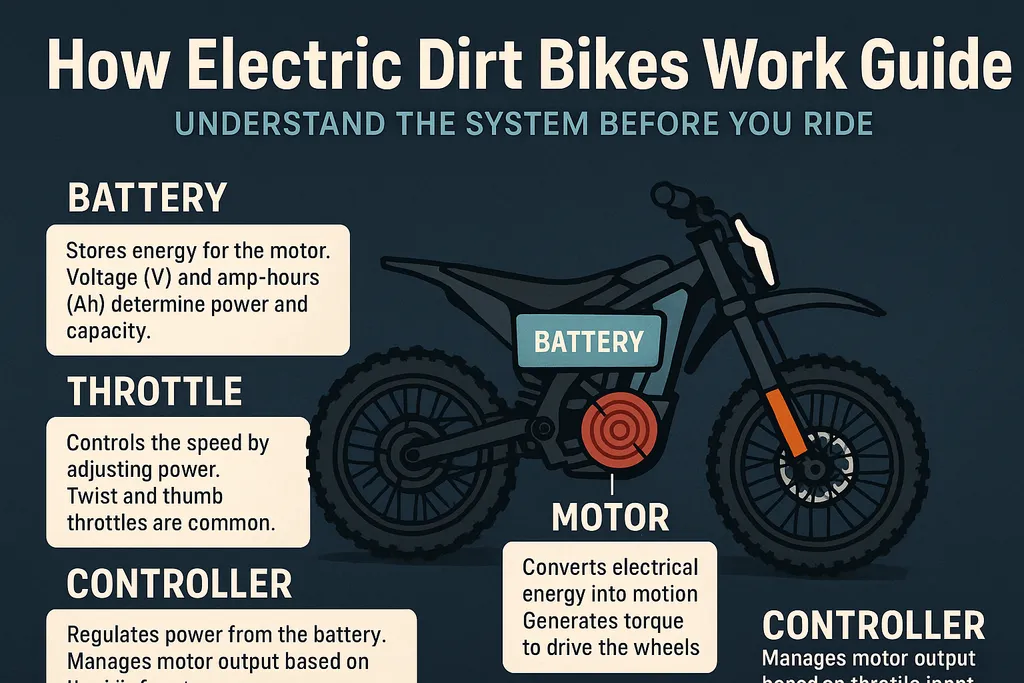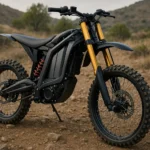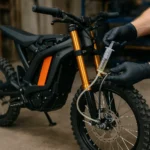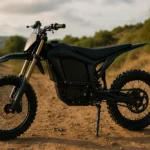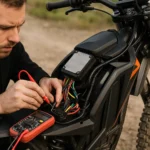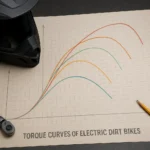Electric dirt bikes are exploding in popularity — but if you’re new to the scene, you might still wonder: how do electric dirt bikes actually work?
In this how electric dirt bikes work guide, we’ll walk you through the entire system in simple terms.
From batteries and motors to controllers and throttles, you’ll finally understand how each part plays a role in powering your ride.
Whether you’re a curious parent or a thrill-seeking teen, this guide breaks it all down.
And if you’re serious about learning even more, stay tuned for our upcoming guide on electric dirt bike parts and maintenance for beginners — part of the same Guides series to help you build confidence before you even hit the trail.
Key Takeaways
- How electric dirt bike systems work in sync
- The role of battery, motor, throttle, and controller
- Why torque, voltage, and amp-hours matter
- Common mistakes to avoid as a new rider
- Tips to extend your battery life and avoid overheating
⚠️ Need a shortcut? Use the links below to jump directly to the part you’re most curious about 👇
The Core Concept: How Electric Dirt Bikes Work
To truly understand how electric dirt bikes work, you need to see them as a coordinated system of parts working together.
In this how electric dirt bikes work guide, we’ll show you that it’s not just about speed — it’s about how energy flows from battery to wheel.
At the center of every electric dirt bike is a battery-powered system that replaces what gas engines used to do.
Instead of combustion and gears, you have electrons, torque curves, and instant acceleration.
The magic happens when the battery, motor, controller, and throttle operate as a single unit.
This guide will help you understand the basics behind each one and how they communicate with each other to deliver smooth, silent power.
Think of it like this:
- The battery is your fuel tank 💥
- The motor is your muscle 🏋️
- The controller is your brain 🧠
- The throttle is your command center 🎮
If even one of these parts is out of sync, your ride won’t perform the way it should. That’s why this how electric dirt bikes work guide exists — to help you connect the dots and ride smarter.
Ready to dive deeper? Let’s break down the battery next — the heart of every electric dirt bike.
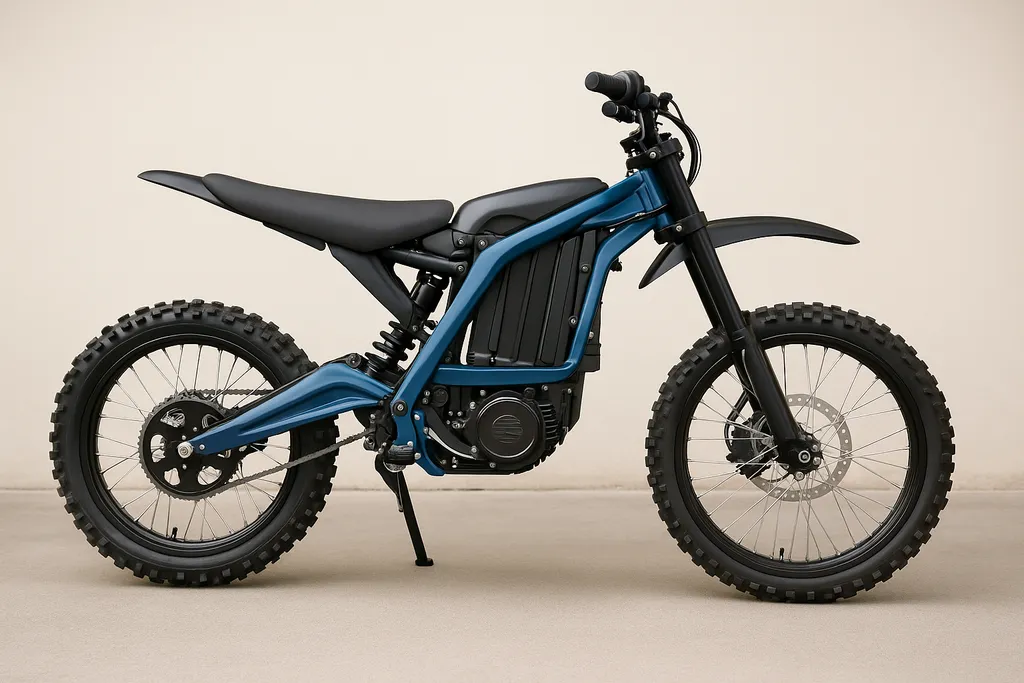
Inside the Battery: Energy Storage and Output
In any how electric dirt bikes work guide, the battery deserves the spotlight — because without it, nothing moves.
The battery stores all the energy your bike needs to accelerate, climb hills, and power through trails.
Most modern e-dirt bikes use lithium-ion batteries because they’re lightweight, rechargeable, and deliver consistent power output.
You’ll often see labels like 36V 10Ah or 72V 40Ah, but what do these numbers mean?
Let’s break it down:
- Voltage (V): This determines how strong the electric push is. More volts usually means more top speed.
- Amp-hours (Ah): This tells you how much energy the battery can store — kind of like how many liters of fuel you have in a gas tank.
- Watt-hours (Wh): Multiply volts by amp-hours and you get the total energy capacity.
A higher-capacity battery doesn’t always mean better if your motor can’t handle the extra juice. That’s why in this how electric dirt bikes work guide, we focus on balance, not just numbers.
Also, don’t ignore battery management systems (BMS) — they prevent overheating, overcharging, and sudden drops in performance.
A good BMS extends battery lifespan and protects you from breakdowns on the trail.
We’ll cover charging habits and performance in the next section, but for now, remember:
👉 The battery is the foundation of your ride’s power delivery. Take care of it, and it’ll take care of you.
Battery Range and Performance Tips
One of the most common questions we get in this how electric dirt bikes work guide is: “How far can I go on a full charge?” And the answer is: it depends.
Your bike’s range is influenced by several factors:
- Rider weight
- Terrain type (flat pavement vs rocky trails)
- Speed and throttle use
- Battery size and efficiency
- Tire pressure and suspension settings
Let’s look at a real-world comparison of how different battery specs impact ride time and charging needs:
| Battery Specs | Estimated Range (Flat Terrain) | Charging Time | Suitable For |
|---|---|---|---|
| 36V 10Ah (360Wh) | ~20–25 km | 3–4 hours | Kids, short commutes |
| 48V 15Ah (720Wh) | ~35–45 km | 4–6 hours | Weekend trail riding |
| 60V 20Ah (1200Wh) | ~50–65 km | 6–8 hours | Long off-road sessions |
| 72V 40Ah (2880Wh) | ~90–110 km | 8–12 hours | Pro-level endurance use |
👉 These are general estimates — aggressive riding or steep climbs can cut your range in half.
Another key tip from this how electric dirt bikes work guide: don’t always charge to 100% unless you’re riding immediately after. Keeping the battery between 20%–80% extends its lifespan.
Want even more range? Lower your average speed, avoid hard takeoffs, and keep your tires properly inflated. Small tweaks = big gains 🔋⚡
And whatever you do — never store your e-bike for months with a fully drained battery. That’s the fastest way to kill it permanently.
In the next section, we’ll explore how the motor converts this stored energy into raw, silent power. Let’s keep going!
Motor Magic: How Electric Motors Generate Power
In this how electric dirt bikes work guide, the motor is where things get exciting.
It’s the part that turns silent electricity into raw motion — and if you’re new to e-bikes, understanding how that happens will change the way you ride.
Electric dirt bikes use either a hub motor or a mid-drive motor, and each has its pros and cons.
- Hub motors are mounted in the wheel. They’re simple, low maintenance, and perfect for flat terrain or urban use.
- Mid-drive motors sit near the crank and drive the chain. They offer better weight distribution and torque, making them ideal for off-road action and hill climbs.
So how does a motor actually work?
When you twist the throttle, the controller tells the motor how much power to draw from the battery.
Inside the motor, magnetic fields push and pull in precise rhythms, spinning the shaft that turns your wheel.
It sounds complex, but this how electric dirt bikes work guide breaks it down:
🧲 Battery = energy
🔁 Controller = signal
🚴 Motor = movement
One major benefit of electric motors is instant torque. There’s no need to “rev up” like gas bikes — the power kicks in as soon as you apply pressure.
⚠️ But here’s a heads-up: more torque doesn’t always mean more fun. Too much torque on loose dirt or gravel can cause wheel spin and loss of control.
Start on lower settings until you get used to the throttle response.
Lastly, motor performance isn’t just about watts — it’s about how consistently the motor delivers power without overheating.
That’s something we’ll touch on again in the troubleshooting section later in this how electric dirt bikes work guide.
Ready to take control? Next up: let’s dive into the throttle and controller, the real brains behind every move.
The Role of the Throttle and Controller
No how electric dirt bikes work guide would be complete without exploring the throttle and controller — two parts that quietly control everything but are often overlooked.
When you twist the throttle, you’re not directly telling the motor to spin.
You’re actually sending a signal to the controller, which decides how much power to pull from the battery and how fast to send it to the motor.
Think of the throttle as the accelerator pedal, and the controller as the brain behind it.
Throttle Types and How They Feel
Most electric dirt bikes come with one of these throttle types:
- Twist throttle (like a motorcycle) — smooth and intuitive for most riders
- Thumb throttle — easier to modulate for kids or casual riders
Your throttle type affects your control over torque, especially at low speeds.
That’s why in this how electric dirt bikes work guide, we always recommend starting on a lower power setting if you’re new to electric torque.
What the Controller Actually Does
The controller is like the bike’s ECU — it processes input, regulates current flow, and applies smart logic. Some advanced controllers include:
- Power modes (Eco, Sport, Boost)
- Regenerative braking for energy recovery
- Safety cutoffs for overheating or low battery levels
Without a well-configured controller, your ride would be jumpy, inefficient, or even dangerous.
💡 Curious about the full anatomy of an electric dirt bike, including how all these systems fit together? Check out our detailed breakdown:
👉 What is an Electric Dirt Bike?
That article will give you the bigger picture, while this guide shows you how each part works on a technical level.
Now that we’ve covered how your inputs turn into motion, let’s move on to the next section — where we answer the most common questions beginners ask every single week.
Bonus: The 7 Most Common Questions Beginners Ask
You’ve already learned a lot in this how electric dirt bikes work guide, but let’s face it — if you’re new to this world, a few burning questions still pop up.
So here are the most common ones we get from new riders, parents, and curious future e-riders 👇
1. Do electric dirt bikes need oil changes?
Nope! One of the biggest perks of electric dirt bikes is low maintenance. No engine oil, no air filters, no spark plugs. Just keep the chain lubed and the battery charged.
2. Can I upgrade my battery or motor?
In many cases, yes — but only if your controller supports it. Always check compatibility before buying.
This how electric dirt bikes work guide recommends sticking to brand-supported upgrades unless you’re tech-savvy.
3. How long does it take to fully charge?
Depends on battery size and charger speed. Most bikes take 4–8 hours to fully charge. Some offer fast charging options, but always check your manual to avoid overloading the system.
4. Are electric dirt bikes waterproof?
They’re usually water-resistant, not fully waterproof. That means rain is fine, but don’t submerge the motor or battery.
Riding through deep puddles or washing the bike carelessly can fry the electronics ⚡
5. Can I mix and match parts from different brands?
Not a good idea unless you really know what you’re doing. Batteries, motors, and controllers often use brand-specific voltages and connectors.
Incompatibility can lead to overheating, failure, or worse.
6. What kind of maintenance do electric dirt bikes need?
Much less than gas bikes. You’ll still need to check:
- Tire pressure
- Brake pads
- Suspension
- Battery health
- Connector cleanliness
But no more engine rebuilds — ever.
7. Are electric dirt bikes safe for kids?
Yes — if you pick the right model and supervise. Many brands offer kid-specific electric dirt bikes with limited speed, soft power delivery, and safer throttle settings.
This how electric dirt bikes work guide encourages starting small and increasing power only when the rider’s skills improve.
Next up, let’s break down the specs and numbers you’ll see on product pages — and what they really mean.
Understanding Specs Like a Pro
If you’re reading this how electric dirt bikes work guide, chances are you’ve already seen specs like 60V 20Ah or 5000W peak on product pages — but what do they really mean?
Let’s break down the spec sheet lingo so you know exactly what you’re getting before you buy:
Voltage (V)
This measures the electrical pressure. More volts generally mean more top-end speed. But high voltage alone doesn’t guarantee a better ride — it has to match your motor and controller capabilities.
Amp-Hours (Ah)
This shows the capacity of your battery — how much energy it can store. A higher Ah rating means longer range, as long as you’re not flooring it every second.
Watt-Hours (Wh)
This is the real deal: Volts x Amp-Hours = Watt-Hours. It tells you the total energy available.
In this how electric dirt bikes work guide, we treat Wh as the most important number for estimating range.
Peak vs Continuous Power
- Peak power is like your max sprint — a short burst the motor can handle for a few seconds.
- Continuous power is what the motor can deliver sustainably.
Don’t be fooled by high peak numbers — it’s the continuous rating that tells you how the bike will feel over time.
Torque (Nm)
This measures twisting force — what helps you climb hills and accelerate fast. More torque = more punch off the line.
If you’re planning to ride off-road or on steep trails, pay attention to this.
Controller Limitations
Even with a big battery and powerful motor, your controller might cap how much energy flows at once.
That’s why this how electric dirt bikes work guide emphasizes system harmony — not just flashy numbers.
Hidden Red Flags
- Marketing terms like “3000W peak motor” without listing continuous wattage
- Low-voltage batteries paired with high-output motors
- Missing torque or Wh specs altogether
- Overhyped “top speed” claims with no context
Now that you can read between the lines of a spec sheet, it’s time to talk about how to keep your ride running smoothly. Let’s move into maintenance mode.
Maintenance & Troubleshooting Tips
One reason people fall in love with e-dirt bikes? They’re way easier to maintain than gas models.
But even in this simplified world, basic upkeep matters — and this how electric dirt bikes work guide has your back.
Weekly Maintenance Checklist 🧰
Even if you’re just a weekend rider, a quick weekly check keeps your ride in top form:
- ✅ Inspect chain tension and lubrication
- ✅ Check brake pads and lever response
- ✅ Clean connectors and charging ports
- ✅ Look for cracks in tires or sidewalls
- ✅ Inspect throttle and handlebar cables for wear
- ✅ Wipe down the frame to spot loose bolts or damage
It only takes 10–15 minutes and can save you hours (and cash) down the road.
Signs of Trouble You Shouldn’t Ignore
This how electric dirt bikes work guide wouldn’t be complete without some basic diagnostics. Watch for these red flags:
- ⚠️ Sudden drops in range (battery degradation or bad cells)
- ⚠️ Jerky throttle response (controller or wiring issue)
- ⚠️ Overheating motor after short rides
- ⚠️ Unusual clicking or grinding near the wheel or motor
- ⚠️ Error codes on display or blinking LED patterns
When in doubt, check your manual, search forums, or reach out to the manufacturer.
Sometimes it’s just a loose cable — other times, it’s a sign your battery is nearing the end of its life cycle.
Pro Tip
Never ignore water ingress — even if your bike is water-resistant. After wet rides, always dry your connectors and ports. Moisture buildup is the silent killer of electronics.
This how electric dirt bikes work guide exists to make your life easier, not overwhelming. A little attention each week keeps your ride safer, stronger, and ready for more fun.
Up next: we’ll go over essential safety tips every beginner should know before hitting dirt, pavement, or track.
Safety Tips for New Riders
Before you go full throttle, let’s take a breather and talk about safety. This how electric dirt bikes work guide wouldn’t be complete without helping you stay upright and injury-free 🛡️
Electric dirt bikes may feel quiet and smooth — but don’t let that fool you. With instant torque, even beginner models can surprise you with their punch.
For more beginner-friendly tips on riding electric dirt bikes safely, check out this comprehensive guide by Electric Scooter Shop.
Here’s what every new rider (or parent of one) should know:
1. Wear the Right Gear — Always
Never skip protective gear. At a minimum, every ride should include:
- 🪖 DOT-approved helmet
- 🧤 Gloves with grip and padding
- 🦺 Jacket or armored vest
- 🥾 Boots that cover the ankle
- 🦵 Knee and elbow guards if off-roading
Even low-speed spills can cause real damage if you’re not protected.
2. Start in Eco or Low Power Mode
Most electric dirt bikes come with multiple power modes. If this is your first ride, start slow.
Throttle response can be sharp, especially on loose surfaces. Ease into the bike before flipping into Sport or Boost mode.
3. Choose the Right Terrain
Stick to flat, open areas for your first few rides. Avoid sand, wet grass, or steep hills until you’re confident with throttle control and braking.
Dirt and gravel can be tricky when you’re still getting used to torque delivery.
4. Understand Braking Distance
Electric dirt bikes are heavier than they look. With regenerative braking and sometimes no clutch, braking feels different than a gas-powered bike.
Practice stopping distance in a safe space. Use both front and rear brakes gently to avoid sliding out.
5. Supervise Young Riders Closely
If your kid is learning to ride, never leave them unsupervised — even if the bike has speed limits.
Use parental control apps or key-activated speed limiters when available. As this how electric dirt bikes work guide emphasizes, it’s not about speed — it’s about safe progression.
You’ve now got the safety essentials locked in. Want to go even deeper into the fundamentals of electric bikes? We recommend starting here:
👉 What is an Electric Dirt Bike?
Next, let’s wrap this ride up with a quick recap and a few ways you can join the community! 📣
Ready to Ride Smarter? Share Your Journey With Us!
If this how electric dirt bikes work guide helped you understand your ride better, pass it on!
Someone out there is Googling the same questions you just had — be the one who sends them in the right direction 👊
We’d love to hear from you:
- Got a tip we missed? Drop it in the comments 💬
- Just bought your first e-dirt bike? Share a photo or tag us on social
- Ran into a problem we didn’t cover? Tell us so we can update this guide for everyone!
Tag us using #ElectricDirtZone and join the growing community of riders helping riders.
Let’s make electric dirt biking smarter, safer, and way more fun — together 🔋🏍️⚡
Oh — and don’t forget to bookmark this how electric dirt bikes work guide for future reference. You’ll be surprised how often you’ll want to come back to it.

Tyler Brooks is the storyteller behind most of the content at Electric Dirt Zone. With over 10 years of experience in digital media and a lifelong love for off-road riding, he blends technical insight from the team with engaging, down-to-earth writing. When he’s not turning dusty trail rides into blog posts, you’ll probably find him snapping pics before things get too wild.

